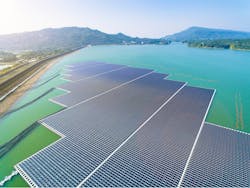Ameresco, Duke Energy and the military are combining forces to create a unique project at Fort Bragg in North Carolina — a floating solar microgrid.
Floating solar projects — solar panels installed on buoyant structures in a body of water — have been gradually emerging worldwide over the last decade. The technology is still relatively rare in the US.
Ameresco and Duke are installing the floating solar microgrid as part of a larger $36 million design-build energy project for Fort Bragg, the world’s largest military base with 50,000 active duty personnel.
An energy efficiency and renewables developer, Ameresco will build the 1.1 MW floating solar photovoltaic system on the 66-acre Big Muddy Lake and pair it with a 2 MW battery system. In collaboration with the utility, Ameresco will tie the system into a microgrid.
Located at Camp Mackall, a remote Special Forces training site at the base, the microgrid will supplement power from the local grid and provide backup during power outages. The Army and Navy have been exploring microgrids as a way to help meet a requirement that they make key facilities capable of providing electricity and water independently for two weeks.
“With one-tenth of the Army housed at Fort Bragg, including Special Operations, Airborne and Global Response Force forces, it is imperative to provide energy security and improvements to the installation’s utility infrastructure,” said Nicole Bulgarino, Ameresco executive vice president & general manager of federal solutions. “We’re eager to get to work installing these energy saving and resiliency measures across Fort Bragg and to support the readiness of the U.S. Army by maintaining a continuous power supply at this critical installation.”
The Fort Bragg project also includes energy efficiency measures, which is characteristic of the large and complex modernization designs undertaken by Ameresco.
Ameresco plans to improve boiler, HVAC, lighting and water conservation systems at the military base. The contract is expected to cut energy use 7% and water use 20% and save the Army more than $2 million in utility costs over one year.
Under the federal utility energy service contract, Duke secures third-party financing to fund construction, and the Army pays down the financing annually with the utility savings that the project generates over the term of the contract.
Construction is slated to begin in November 2020.
Based in Framingham, Massachusetts, Ameresco has undertaken a range of similar initiatives that incorporate microgrids as part of facility improvement plans. They include projects at Northeastern University in Boston, Mass., the Portsmouth Naval Shipyard in Kittery, Maine, and the Marine Corps Recruit Depot (MCRD) in Parris Island, South Carolina.
Track news about floating solar microgrid projects. Subscribe to the free Microgrid Knowledge newsletter.







